JAINISM
The Jains "deny god, worship men, and nourish vermin."
-- Washburn Hopkins.
Comments on Michael Tobias' video "Ahimsa: Non-Violence"
Jain doctor's position on abortion. Isn't it inconsistent with the doctrine of ahimsa? Are such exceptions taken with regard to animal life? Isn't the doctrine of reincarnation the strongest argument for the anti-abortion position? In the West we can say that the fetus is not a person until late in pregnancy, but in India our personal identities (located in Jain jiva or Hindu atman) are uncreated and eternal.
Caste system did creep back into Jainism. The Karnataka (southwestern state) Jains did not allow untouchables into their spiritual community. Hierarchy even exists among the gods: some are servants who do work for the higher gods. "Altogether there are in heaven and hell ninety-nine kinds of gods who are regarded as menial because they serve" (Stevenson, The Heart of Jainism, p. 270).
No biography of Alexander the Great that I have read mentions the story about him and the Jain monk, at least taken as history. Alexander turned back because his Macedonian troops refused to continue the Indian campaign. In his book Life Force: The World of Jainism Tobias does admit that the story may not be true (p. 62).
Some Indian kings were Jains and they did wage war as all Indian kings did. One famous exception among Indian political leaders was Ashoka, the great Buddhist emperor of the 3rd Century BCE, who instituted a unilateral disarmament and, as a result, the Indian subcontinent enjoyed 150 years of relative peace. The first king of the Maurya dynasty Candragupta became a Jain monk, but only after leaving a record of incredible violence behind him. Ashoka, by the way, was the third king of this dynasty.
Mahavira condemned only those who engaged in offensive warfare; those soldiers who kill only in self-defense would not receive karmic debt (Tobias, p. 100); in fact, they had a chance to enter heaven. The occupational category asi (lit. "the sword") was a way of living approved by Jain scripture. A Jain may train with weapons as long as they are used only in self-defense. (Does this mean that a Jain can kill a tiger in self-deferse?) Tobias also discusses an Orissan king (1st Cent. B.C.) who was called a military victor, but Tobias claims that "there is no mention of his having ever killed an enemy" (ibid.). Needless to say, the Jain monks are prohibited from training with weapons or going to war.
Possible origin in the Harappan civilization. Pacifistic society with a devotion to animals. Jain yogic postures and symbols appear to be present. Yoga postures named after animals. Three and four-faced figures of the same style that some Tirthankaras are depicted. The bull seals of the Harappans and the bull symbol of Rishabha may be connected. The main problem with this view is that Jainism has always been connected with the northeast region of India.
"Saints" Tirthankaras (lit. "Ford-finders"), of which there are twenty-four, are those who have reached the other side of Samsara. These twenty-four have appeared in the first half of this time cycle (200 billion sagaras, see below), and twenty-four more will appear in the second half.
First Tirthankara: Rishabha (the
"bull," mentioned in the Rig-veda along with naked ascetics) Lived
8,400,000 years. He was born 100 billion sagaras ago. (A sagara is 100 billion
palyas, which is a period in which a well a mile deep filled with fine hairs can
be emptied if one hair is drawn out every 100 years!) Rishabha introduced
agriculture, the caste system, law, monarchy, and the true path of liberation.
In the Hindu Bhagavata-purana Rishabha is considered to be a minor
incarnation of Vishnu.
Rishabha had at least two sons--Bharata, after whom India is
named, and Gommatesvara Bahubali, his younger brother. The latter is
immortalized in stone in the Jain colossus at Sravanabelangola in Karnataka
state. He is depicted in his state of liberation with creepers crawling up his
totally immobile body and ant hills building at his feet.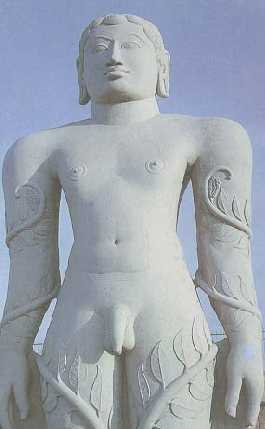
The 19th Tirthankara was Malli, a beautiful woman, who,
according to Tobias, exposed "the banality of her body to would-be suitors" (p.
71). Only the Shvetambara sect believes that this saint was a woman. Even here
the fact that the 19th was female was minor punishment for a small deception
that her previous male incarnation had performed.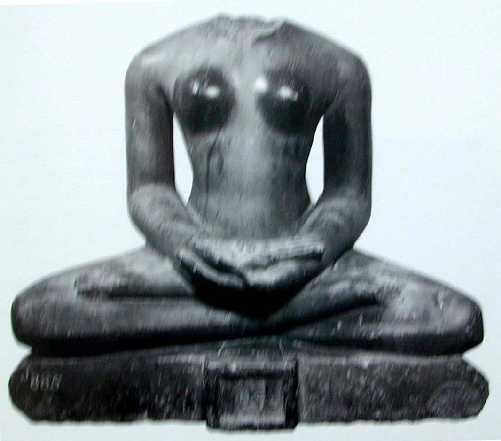
22nd Tirthankara is Arishtanemi, who was said to be a cousin
of Krishna. The Jains date him at 1450 BCE, too early for most scholarly dating
for Krishna. Interestingly, at least as far as a connection to Krishna is
concerned, Arishtanemi's symbol is the conch shell.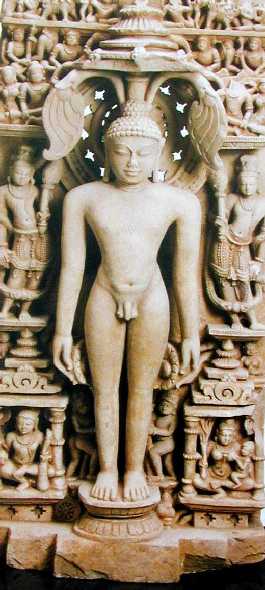 Image of Nemi shown below and left.
Image of Nemi shown below and left.
23rd Tirthankara is Parsva 872-772 BCE (serpent).
Image shown below right.
24th Tirthankara was born Nataputta Vardhamana, but was called
Mahavira (lit. "great hero") and associated with the lion.
(Statue below is found in New Delhi.) His dates vary:
599-527 "white clad"; 581-509 "sky clad"; or 552-480 or 540-468 by some
scholars. Interestingly enough, only the first and the last two Tirthankaras
went around nude.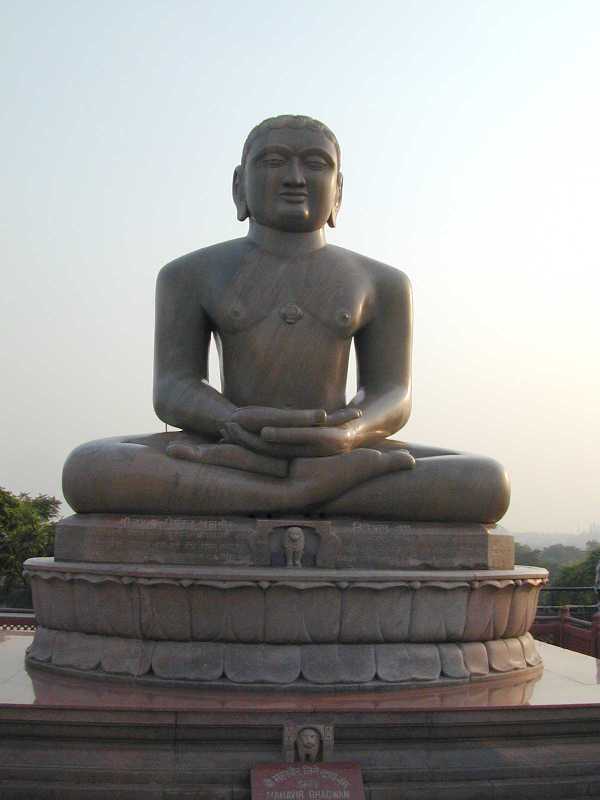
Mahavira and the Savior Archetype: Miraculous conception. Original conception in a brahmin mother, but one of the gods Sakra intervened and transferred the embyro to a kshatriya mother. (This part of the story seems to make the political point that the kshatriya caste is now more important than the brahmin caste.) Mahavira never kicked in the womb, holding to non-violence from conception on. Vedic gods bow down to him. He was sinless, omniscient, an incarnate deity as a royal prince. He chose eleven original disciples, whom he taught through a supernatural divine monotone (Digambara) or special language that all beings can understand (Shvetambara). All of these disciples were brahmins, again showing the subversion of the Vedic preference for the brahmin caste in all things spiritual.
The Great Renunciation at age 30. At 31, he became "sky-clad." The Greeks called them gymnosophists (naked philosophers). 12 yrs. of mortification of the flesh and liberation in the 13th year. He slept for only 48 minutes during this time. He was called Lord of the Triple Worlds--Heaven, Earth, and the Underworld. His wealthy parents starved themselves to death when Mahavira was 35 (other sources say at the age of 31).
The Jains reject all Vedic authority, worship, and sacrifice. Also counter to Hinduism, one does not need a guru to become a saint. Jainism constitutes a form of spiritual humanism, which is defined as any religious view that states that salvation is achieved strictly by human effort alone.
Jainism and Buddhism
"Out of the theory and practice of religious life current in their time Gautama Buddha fashioned a beautiful vase; Mahavira, a homely but still durable pot."--Eliot
Misconception: Buddhism survived as Jainism after Buddhism spread to other Asian countries. The fact is that Buddhism died out in India for its own reasons, and Jainism resisted the assimilation that Hinduism succeeded in vis-a-vis Buddhism. For example, Buddhists did not protest when Hindus made the Buddha an incarnation of Vishnu. Buddhist monks and monasteries had become rich and corrupt, and the rise of Tantric Buddhism marred the reputation of Indian Buddhism.
Jain scripture never mentions the Buddhists, but the earliest Buddhist writings do mention Jainism. Indeed, the Buddha studied under Jains during his six years of wandering.
Similarities
Differences
Important Jain Dates
513 BCE - schism between Digambaras (sky/space-clad) vs. Svetambara (white-clad) sects. Note: their idols are respectively unclad and clad.
400 BCE - first image of Mahavira erected for worship.
310 BCE - 12,000 migrate south
250 BCE - Buddhist emperor Asoka donates five caves to the Jains.
82 CE - Two sects split definitely (community first)
650 CE - first major persecution - 8,000 Jains were impaled.
1174-76 - Another Hindu king persecutes the Jains and destroys their temples.
1297-1298 - First Mogul conquests wreaked havoc on the Jains. Digambaras had to wear clothes.
1474: A separate sect--Sthanakvasis--breaks away, deciding that building temples and and worshiping idols is contrary to true Jain beliefs.
1542-1605 - Akbar the great attempted to get all the religions together.
Jainism and Women
Mahavira: "Women are the greatest temptation in the world. . . He should not speak of women, nor look at them, nor converse with them, nor claim them as his own, nor do their work" (Sacred Bookds of the East, vol. 22:48). "He, Mahavira, to whom women were known as the causes of all sinful acts, . . . (ibid., vol. 22:81).
Digambaras did not allow women into the Sangha. But the Svetambaras allow them to take ascetic vows, to become nuns, and to hope for a male incarnation. As reborn males former women could then become Tirthankaras.
Please keep these two paragraphs in mind when you read about women in the Prem Suman Jain article on reserve.
Note: The two main sects of Jainism do not communicate with one another. The only common activity is the celebration of Mahavira's life. The Digambaras completely reject the Shvetambara's canon, and they refuse to worship in the latter's temples, primarily because they dress up and adorn their statutes. The Digambaras have much less emphasis on scripture and much more stress on spiritual practice. Note: The great irony here is that Hindu sects are much more tolerant of one another than these two Jain sects!
The Seven Colors of the Soul. See story in Tobias, p. 69.
The First Trinity of Janism: asceticism (self-denial and non-possession), anekantavada (non-absolutism), and ahimsa (nonviolence).
Theory of Knowledge: Many-sided-ness (anekantavada). The blind men and the elephant. Critical of other Indian systems, which were ekantavada--"one-sided." But strictly speaking Jainism is one-sided, not agnostic, because it does hold to its one view, while recognizing the possibility of the truth of other perspectives.
Panzooism: universe as living organism filled with living jiva-souls. The universe is a sympathetic continuum in which all things feel and all things suffer. Note: not all jiva souls have a mind (manas): only gods, humans, and higher animals have manas. So this panzooism is not a form of idealism (all things are minds) or panpsychism.
Jain panzooism is the basis for its ecological philosophy, summed up beautifully by Mahavira: "One who neglects or disregards the existence of earth, air, fire, and water and vegetation disregards his own existence which is entwined with them" (Tobias, p. 7).
Panzooism and strict vegetarianism encouraged Jains to be very observant of nature and its many species. Jain biologists identified 875,000 different species, an amazing bit of science compared to Aristotle's paltry five hundred.
Tobias: "While the Middle Kingdom Egyptians were building pyramids to house a few immortal Pharaohs, the Jains were building pyramids of thought to house an immortal earth with billions of immortal souls" (p. 69).
Source Book, p. 252
The Second Trinity of Jainism: Right Faith (better than "belief"), Right Knowledge, and Right Conduct. Right faith includes belief in the omniscience of the spiritual teachers and their infallible guidance. Right conduct will be discussed later. See text on right faith in Frazier, pp. 252-55.
Five Kinds of Knowledge
Note: Does this mean that many-sidedness is lost in kevala? Yes, it does.
1 & 2 are mediated 3,4,5 are immediate and direct.
Objects of 1 & 2 are the six substances (motion, rest, space, soul, matter, time) object of 3 is matter; of 4 is subtle matter. Objects of 5 are the six substances and all their modifications. Suprasensory cognition of everything.
1,2, & 3 may be fallible. Clairvoyance may be wrong?
Kevala Knowledge (Gopalan, Chap. 11): It is perfect, complete, unique, absolute, pure, all-comprehensive, know. of the world and non-world (i,e, possible worlds). The Jain saint is omniscient and perfect. He represents the "consummation of all knowledge through the progressive removal of the obstructions caused by the sense organs and the mind." Karma causes obstructions to this knowledge.
Contrasts with Sankhya-Yoga dualism: purusha soul knows only itself, while jiva soul in Jainism knows everything. Real infection of karmic "particles" as obstacles to kevala jnana. Different ideas about the status and role of matter.
Gopalan, 77: Critics of kevala-jnana ask: how is know. of contraries (world and non-world) possible? Answer: In lightning we perceive both light and darkness (?!!)
Does the jiva soul know all forms of time in the same way that the Christian God knows all time as an Eternal Now. No, the Jains answer, the saint knows the past as past, the present as present, and the future as future. In either view, there is a basic problem of knowing the future: If the future is not yet actualized how is it possible to know it? Furthermore, knowledge of the future appears to close the future and make free will impossible.
How can the jiva perceive temporal succession it he is outside time? (Same questions obtains for the Christian God.) The Jain saint can see into the past as well as into the future. But wouldn't that be perceiving the past and the future as present and actual? The Jain saint can "penetrate" both time and space.
Source Book, p. 255
The six substances are divided according to conscious and non-conscious and non-extended vs. extended such that we have one non-extended conscious substance (jiva), four non-conscious extended substances (motion, rest, space, matter), and one non-conscious, non-extended substance (time). See the explanation of the functions of the six substances on the top of SB, p. 256. Please note that the function of selves is to support each other (#21).
The relation of cosmology to the substance is as follows. There is our limited world (loka) and the infinite world (aloka). Motion (dharma) and rest (adharma) operate only in the finite world where jivas live in bodies. The finite world is divided into the triple world of four realms of beings: gods, humans-animals-plants (two realms of beings on one level), and the underworld.
The inifinite world (aloka) is where the saints reside.
For each unit of space there is a unit of matter, and both space and material atoms are infinite. Atoms also form into molecules. Jains are proud of the fact their atomistic theory corresponds so well with Western scientific atomism. Unfortunately, these views do not correspond well with the discoveries of contemporary physics.
Time is a non-extensive substance. Like space, it is also infinite, so there will be infinite cycles of time with no end or beginning. This means that the universe is eternal, never created or destroyed.
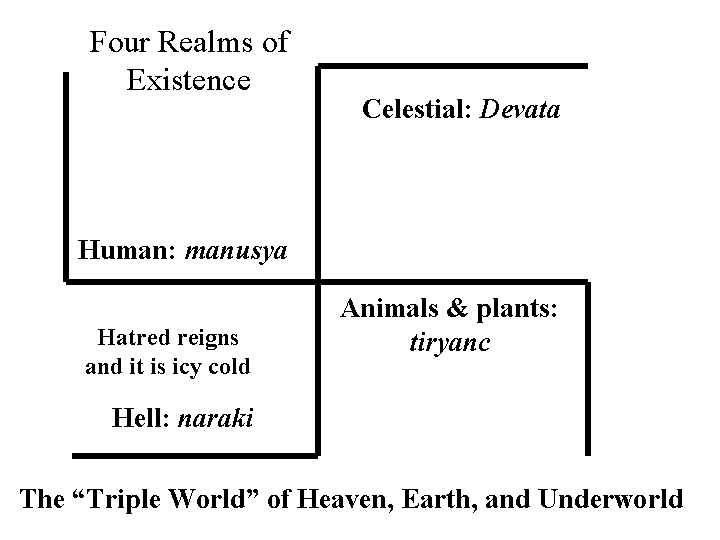
Good and bad gods? (Frazier, p. 256) 25 different types of gods, 18 of which may be "bad." Buddhist may have called them "hungry ghosts." Dissatisfied spirits. See Gopalan, pp. 137-38.
Hatred is the innate quality of the denizens of Hell. The higher levels are too hot, but the lowest levels of Hell are icy cold-- just as the Christian Dante envisioned it.
Jain Ethics, Source Book, p. 257, Chap. 7.1
Five Precepts: Ahimsa, truth-telling, no stealing, chastity, and nonattachment and nonpossession (celibacy for monks)
7.2 Greater and lesser vows (same in Buddhism) with regards to faults in Chap. 6:13-25. Total abstention (ascetic) vs. limited abstention (householder). 7.3 Five meditations for ahimsa. Five meditations also for the other 3, but not the 5th. Chap. 9 is roughly equivalent to the Buddhist 8-fold path, esp. the last on "concentration" (samadhi). Four jhanas, levels of highest meditation, just as in Buddhism.JAINISM AND AHIMSA
It is in Jainism that we find the most radical theory and practice of ahimsa. Ahimsa is the first of the five great vows of the Jains, the others being truth telling, not stealing, celibacy, and nonpossession. As a moral principle, ahimsa rules supreme. The four other commandments are strictly subordinate, so that lying to prevent killing is morally permissible. Furthermore, ahimsa goes beyond physical injury, as can be seen in this passage from the Ayaramgasutta: "One may not kill, ill-use, insult, torment, or persecute any kind of living being, any kind of creature, any kind of thing having a soul, any kind of being." The practice of ahimsa requires not only good action but pure intentions as well. As the Pravacanasara states: "The soul is defiled even though there may not be any actual injury to life. [But] a careful and a pious person who is not disturbed by passions and who is kind towards animals will not suffer the sin of violence, even if, by accident, injury is caused to life" (3.17).
Jain ahimsa led to the most severe restrictions ever imposed on human action. (Critics have said that the extreme asceticism required of Jain monks actually amounts to self-injury.) The only exception allowed in the practice of noninjury is that householders may kill "one-sensed" organisms, but the monks may not kill any living thing. Therefore, Jain monks pluck their hair (rather than risk killing lice), filter their water and air, and sweep their paths before them. Jain metaphysics holds that all living things have a soul (jiva); therefore, ahimsa is based on the equality and universal kinship of all souls. From this basic communion the Jains are able to promote an ethics of complete compassion and tolerance.
Tobias, 88: Three types of violence
Gopalan on Jain Ethics, pp. 159 ff.
Even though ahimsa is phrased as a negative, it embodies a positive philosophy of love that is as radical, or more so than Christian agape, because it extends to animal-plant world.
162: Satya--Truth-telling. If an animal is concealed and a hunter is after it, one is not obligated to tell the truth where it is. A Jain can always lie in order to prevent a killing. Asteya--not stealing. One is even prohibited from wanting to take another's property. The Jain has to be aware of sales, if the sale items were acquired by devious means. "Underground" and "unclaimed" property belong to the King!
Brahmacarya (celibacy): For the monk or nun this means complete abstention from sex. Thought and deed. For the householder, it means monogamy -- also in thought and deed. Aparigraha -- non-possession -- also in thought and deed fro the monk or nun. Better conceived, esp. for the householder, as non-attachment to the things possessed.